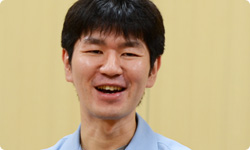You intended to make Devilish Brain Training quite quickly, so why did it take so long in the end?
This title represents rather an abrupt shift from a fun training game for your brain to an altogether more intense workout, and we were concerned that players would approach this game with the expectation that it would be like previous games in the series. We thought that we should significantly change its image so players could tell at a glance that this was different, and we experimented with a lot of ideas in order to achieve this.
What kind of ideas did you try?
The first proposal was to name it Hellish Brain Training so the difficulty would be explicit and easy to pick up on.
Ah, I can imagine the title logo you came up with! (laughs)
Dr. Kawashima even has a volcano on his head, so that he’d erupt when he got angry!
Kaboom!
You took it that far? (laughs)
We did! (laughs) That was our initial proposal, but then fans of the previous Brain Training games wouldn’t touch it!
So you’d gone a little overboard in stressing the difficulty…
Right. Then we decided we wanted it to be training that was difficult while at the same time being fun, and we brainstormed some more. We considered giving it a story, as well as making it into a kind of simulation.

Really? Brain Training as a simulation game? (laughs)
That’s right.
We were tossing around the wildest ideas.
We really were! (laughs)
What kind of ideas?
They’re a little embarrassing, but there was this ultra-cute anime-style character and you…
An anime character?
And you would help her develop….
In Brain Training?
Yes.
Just what kind of audience were you going for? (laughs)
(laughs)
We also discussed using celebrities.
Right. Personalities who get picked on are pretty popular on television. So we wanted to use a real image of a celebrity, and they would be a bit slow at first but would eventually get really clever.
There was a little animal for a while, too. A bird, wasn’t it?
A bird?
Yes. You would raise a bird. And then there was an idea that involved enhancing a robot.
At that time, everything was on the table!
You had really gone off road, so to speak! (laughs)
Indeed we had. We went off road for at least six months.
Then, while Kitamura-san was coming up with all these off-the-wall ideas, Takahashi-san and Kawamoto-san, you were busy with the development of the Nintendo 3DS system, so you couldn’t give her ideas the attention they deserved.
Right. When we got a proposal from her, we would be able to say, “That’s no good, I’m afraid” but not much beyond that…
So you could tell when something wasn’t heading in the right direction.
Yes, but...
We couldn’t spend much time on it because we were tied up with the development of the Nintendo 3DS system, so we couldn’t suggest the right route to go.
I think we really put Kitamura-san through the wringer for about half a year.
How did you finally escape that six-month period where you had gone off road?
Well, it was during that period when the release of Nintendo 3DS was announced.
There was momentum building within the company to the effect that if we were going to make something, it should be for Nintendo 3DS.
Yes, so we decided we should remake it from scratch for Nintendo 3DS. It was just at that point that Ito-san joined the team.
Ito-san, you had wrapped up the work you were doing on the Nintendo 3DS system, and you found yourself drawn into this project.
Yes. Actually, they tricked me.
Now, when you say they tricked you, you mean that they initially told you that you’d be working as a programmer...
That’s right, but I ended up having to do all kinds of other things too!
What was your first impression when you joined the project?
To be honest, when I first tried the n-back exercises, I thought, “What on earth is this?”(laughs)

(laughs) What was it that made you react like that?
It was so hard! It felt like I was being forced to use brain functions that I usually try not to!
So you tried it out and thought things like “I’ve never used my head so much!” or “I’ve never concentrated so much before!”
That’s right! I thought if we released this title with just the n-back exercises, a number of players would have to fall by the wayside, so we left those as they were but tried out a number of ideas using sound and moving graphics to see if we could make it more fun.
And how did that turn out?
(disappointedly) It didn’t get any more fun.
So even if you use sound and moving images to relieve stress, memorising things while doing calculations at the same time is going to cause considerable stress.
Precisely.
I imagine it was like setting a test with 100 problems, and then deciding to take three problems and reduce them to one. The fundamentals don’t change.
That’s right. And if we had changed that fundamental element to make it more fun, it wouldn’t function as a training exercise anymore.
So after Kitamura-san experimented with a process of trial and error for six months to no avail, Ito-san then found himself equally at a loss. How did you eventually come to see light at the end of the tunnel?

Well, that didn’t happen until the very end.
Really? But I thought it was about six months ago.
Was it really?
I suppose it must have been such a gruelling, protracted process for you that it felt like it only came together right at the end.
Yes, I suppose that must be it! (laughs) I think we finally had a breakthrough once we had gone through this process of trial and error to make the training exercises more enjoyable. We basically realised that if it wasn’t difficult, it wouldn’t really qualify as training anymore. We also finally managed to come up with solutions, for instance in the way we presented the exercises, as to how to sustain player motivation for an extended period.
© 2024 Nintendo.